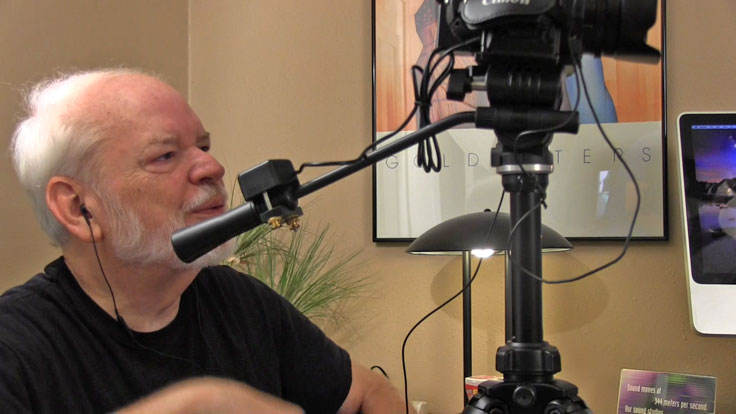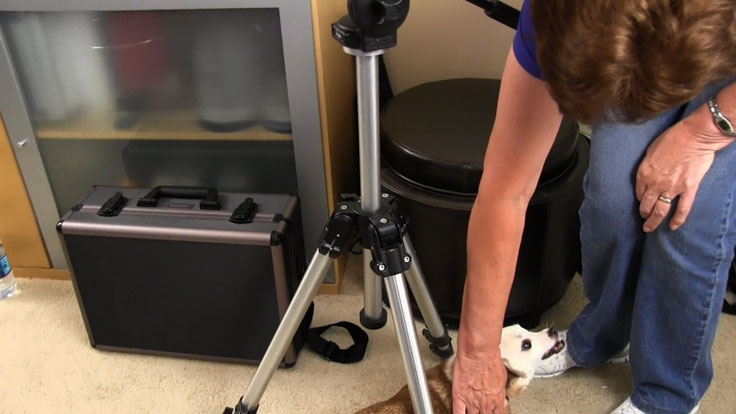
Joel Block
The Block House
 |
Joel Block The Block House |
|||
Chris and Martin Theophilus (Phantom Productions, Inc.) interviewed Joel Block at The Block House Studios for the Museum of Magnetic Sound Recording. Please view the video below.
Joel's experience adds another dimension to the Museum's capturing of magnetic audio recording. His experience comes from radio and in the area of commercials, audio books, industrials, jingles and spoken word projects. We believe you will find the information about Joel's dad, Martin Block, to be fascinating as well. We hope you enjoy this MOMSR interview with Joel Block.
Photos from The Block House studio web site • Delores and Joel Block, the studio and Lainie (voice coach) & daughter Marlie Fraiser
Photos from the past
Some photos from the Block House Studios' interview for the Museum of Magnetic Sound Recording



© 2015 The Block House Studios and the Museum of Magnetic Sound Recording • video domated by Phantom Productions, Inc.
The Museum, which is privately owned, is working to create an Austin Music and Recording Technology Museum. We appreciate your support!
Martin Block
In 1935, while listeners to New York’s 1130 WNEW in New York were awaiting developments in the Lindbergh kidnapping
, Martin Block built an audience by playing records between the Lindbergh news bulletins. This led to Block’s show, Make Believe Ballroom, which began February 3, 1935. Block borrowed the concept and the title from West Coast based disc jockey Al Jarvis. The idea was to create the illusion that the broadcast was from a ballroom with the nation’s top dance bands performing live. Block bought records from a local music shop since WNEW did not have a record library. Block purchased five Clyde McCoy records, selecting his “Sugar Blues” for the radio show’s initial theme song. In doing so, Block became the first “Disk Jockey” in the city of New York!
Block was told by the station’s sales staff that nobody would sponsor a radio show playing music, so he had to find a sponsor on his own. Block, a trained salesman, found “Retardo”, a diet pill manufacturer. Within a week, the sponsor had over 3,000 responses to the ads on Block’s radio show.
Martin Block’s style of announcing was considerably different than the usual manner of delivery at the time. Instead of speaking in a voice loud enough to be heard in a theater, Block spoke in a normal voice, as if he was having a one-on-one conversation with his listeners. Block’s personal style was a big seller of products. One of Block’s sponsors offered a sale on refrigerators during a New York snowstorm; 109 people braved the elements for the bargain refrigerators Block advertised on air. Blocks success did not go unnoticed. By 1941, potential sponsors for his show had to be put on a waiting list for availabilities. Block was famous for throwing away the sponsor’s advertising copy and then developing his own text free style.
Make Believe Ballroom was nationally syndicated in 1940. Block and Make Believe Ballroom made the cover of Billboard magazine in April, 1942. By 1947, there were two daily editions of the Make Believe Ballroom: one in the late morning and another around dinner time. In 1950, he celebrated his 15th anniversary on the air. Variety devoted an entire section to Block and his career.
Block co-wrote the Glenn Miller hit, “I Guess I’ll Have to Dream the Rest”. Miller also recorded a version of the Make Believe Ballroom theme, titled “It’s Make Believe Ballroom Time” which Block was credited with the lyrics. The theme was used for the show up until the end of terrestrial WNEW-AM in 1992.
Fannie Rose Shore auditioned for the Block’s radio show singing “Dinah”. Block declared that “Dinah Shore” had won the spot on his radio show. Block’s memory lapse mistakenly gave a very young Fannie Shore the name Dinah Shore; this name would stick with her throughout her infamous career.
Block left Make Believe Ballroom in 1954 to host The Martin Block Show for ABC Radio originating from the network’s New York flagship WABC. Martin officially retired from ABC and radio in 1960, stating his retirement merely meant not working in the medium on a regular basis. In the latter part of his career, Martin Block was heard on WOR in New York from 1962 until his death. Additionally, Block hosted a public affairs show, Guard Session, for the U. S. National Guard.
Blocks catch phrase: “For you and you and especially you.” metromediaradio.net
Segarini: Theatre of the Mindless bobsegarini
Radio historian Rick Busciglio explains how the Lindburgh baby trial led to a template for what was to come: “Martin Block was one of the key reasons that I followed a career in broadcasting. He was the most popular DJ, on the most popular non-network radio station in the New York metro area, WNEW. In the mid-1930s, moved to New York from California, bringing with him a new idea conceived by Al Jarvis, at KFWB in Los Angeles (where Block had been a junior assistant). Jarvis’ revolutionary concept – playing records on the radio.
From the early thirties, Jarvis’ “The World’s Largest Make Believe Ballroom” was on six hours a day and became a local success. But in 1932 Los Angeles, which is now the nation’s second largest market was not considered a major market. Jarvis’ program thus received very little attention outside the Los Angeles area, and enjoyed nowhere near the success of Block, who would become the nation’s number one radio personality for nearly a quarter of a century using a virtually identical format.
The program’s concept: Block pretended that the artists were performing live in the studio “ballroom” with him, as he spun their records. The beginnings of Block’s “Ballroom” show can be traced to February 3, 1935, when, on WNEW, he was broadcasting the trial of Richard Bruno Hauptmann who was ultimately convicted of kidnapping and killing the infant son of aviator Charles A. Lindbergh. During a long break in proceedings, Block decided to play some records, but the station didn’t own any, so he was forced to buy his own. Legend has it that he rushed around the corner to the Liberty Music Shop, returned with five Clyde McCoy records, and played them back to back to make it sound like a live broadcast from a dance hall. Block ad-libbed introductions that made it seem like he was actually chatting with McCoy, a Louisiana band leader. It is likely that among these records was what would become McCoy’s theme song, “Sugar Blues,” which had just been released a few days earlier.
As the trial wore on, Block continued spinning records in his “Ballroom” style to fill in the periods between broadcasts direct from the courtroom. Within a few months, this evolved into the “Ballroom” show playing name bands for 15 minutes at a stretch.
After the trial ended, the makeshift show was retained due to requests from thousands of listeners.
In just four months his unscripted, easygoing style, combined with music solely from records, drew an audience of four million listeners, and the show was extended to two and a half hours. Advertisers lined up to sponsor the program: one department store reported that Block’s ad-libbed commercials sold 300 refrigerators during a blizzard, and when he made a wartime appeal for pianos to entertain the troops, the USO was offered 1,500 of them.
In 1940 the Federal Communications Commission relaxed its rules about identifying pre-recorded materials, requiring that they be identified only twice every hour. In that same year the courts ruled that the warning on record labels prohibiting broadcast use had no legal significance. From then on radio shows featuring recorded music became increasingly popular.
“It was Block, according to the author of a book commemorating WNEW’s fiftieth anniversary, who inspired Walter Winchell to coin the term “disk jockey.” Yet Bill Randle, one of the deans of the profession, has traced the term to the late Jack Kapp, a record executive who called DJs “record jockeys” in 1940 — possibly because their job often included controlling the sound volume, or “riding the gain,” on their records. However they got their tag, the radio field was soon filled with disk jockeys.” – Ben Fong-Torres in his book The Hits Just Keep On Coming, Miller Freeman Books, San Francisco, CA, 1998
If big band music was jazz, then Al Jarvis and Martin Block were the first jazz disc jockeys.On October 11 1940, Glenn Miller recorded “Make Believe Ballroom Time” for RCA-Victor’s Bluebird subsidiary label at the Victor studios in New
York City. It would become the theme song for Block’s “Make Believe Ballroom.” Miller had been so taken with the show’s concept that he actually paid for the “Make Believe Ballroom Time” recording session himself and hired the Modernaires to join in. By 1940, Martin Block could “make” or “break” records. If he played something, it was virtually guaranteed to become a hit; if he ignored it, it “died.” By the end of the war, the hit-making power of radio disc jockeys had earned them much greater respect in the music business, and Block was the undisputed “king” of the disc jockeys.
Block skillfully created the aura of doing a “live” radio program, complete with performers like Harry James or Nat King Cole (on records) “…from the Crystal Studios of WNEW.” At that time, the show’s famous crystal chandelier was as “make believe” as the “ballroom.” But the tremendous popularity of the show, heard twice daily, six days a week, led WNEW to construct a studio in ballroom form with a huge crystal chandelier and a red velvet chair for Block. His verbal imagery also included the “revolving stage” (actually his turntable) – upon which the artists performed:
“And now, Mr. Frank Sinatra ascends our revolving stage to sing ‘Nancy with the Laughing Face’.”
As a result of the work these radio pioneers; radio disc jockeying became a fully accepted profession and an integral part of the music industry in the fifties and the sixties. The disc jockey thus became a powerful hit maker whose patronage could an artist’s career overnight.
In 1954, Martin Block left WNEW for WABC. He died on September 18, 1967.
Thank you for viewing our site! We hope you have found our information helpful and interesting. We are committed and passionate about preserving the history of recording. Please consider making a donation. Every little bit helps us protect and preserve these significant vintage recording devices and information.
We offer seven hours of 50 video segments via download about our collection and the history of magnetic recording available at this link.
ORDER THE VIDEO FILES ON LINE - was
14.95NOW only $9.95
There are 50 QuickTime H264 854 X 480 files in this download. Play on MAC OS or Windows Media Player
We provide 48 hours during which to download the files. After that the file access will expire. Once the files are downloaded they are yours to keep.
© 2018 Museum of Magnetic Sound Recording • Webmaster • All pictures and content on this web site are the property of the Theophilus family,the Museum of Magnetic Sound Recording and reel2reeltexas.com • Photos of items in our collection are available for sale. We do NOT provide copies of ads, nor photos from other sources! All photo work is billed at studio rates and a deposit is required.